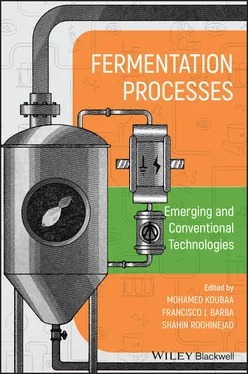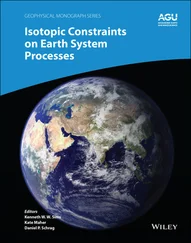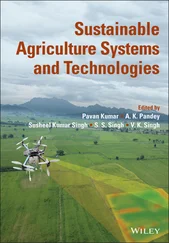5 Cao, H., Chen, X., Jassbi, A.R., and Xiao, J. (2015). Microbial biotransformation of bioactive flavonoids. Biotechnol. Adv. 33: 214–223.
6 Carnes, A.E. and Williams, J.A. (2014). Plasmid fermentation process for DNA immunization applications. In: DNA Vaccines: Methods and Protocols, Methods in Molecular Biology (eds. M. Rinaldi, D. Fioretti and S. Iurescia), 197–217. New York, NY: Springer New York.
7 Carnes, A.E., Hodgson, C.P., and Williams, J.A. (2006). Inducible Escherichia coli fermentation for increased plasmid DNA production. Biotechnol. Appl. Biochem. 45: 155–166.
8 Charles, M. (1999). Fermenter design. In: Encyclopedia of Bioprocess Technology: Fermentation, Biocatalysis, and Bioseparation (eds. M.C. Flickinger and S.W. Drew), 1157–1189. New York / Chichester / Weinheim / Brisbane / Singapore / Toronto: Wiley.
9 Cooper, G.M. (2000). The Cell: A Molecular Approach. Washington, D.C.: ASM Press; Sinauer Associates.
10 de Souza, P.M. and de Oliveira Magalhães, P. (2010). Application of microbial α‐amylase in industry – a review. Braz. J. Microbiol. 41: 850–861.
11 Defavari do Nascimento, D. and Pickering, W. (2017). Plant‐Based Genetic Tools for Biofuels Production. Bentham Science Publishers.
12 Drévillon, L., Koubaa, M., and Vorobiev, E. (2018). Lipid extraction from Yarrowia lipolytica biomass using high‐pressure homogenization. Biomass Bioenergy 115: 143–150. https://doi.org/10.1016/j.biombioe.2018.04.014.
13 Dunford, N.T. (2012). Food and Industrial Bioproducts and Bioprocessing. Chichester, West Sussex, UK: Wiley Blackwell.
14 Eş, I., Khaneghah, A.M., Hashemi, S.M.B., and Koubaa, M. (2017). Current advances in biological production of propionic acid. Biotechnol. Lett. 39: 635–645.
15 Ferrier, D.R. (2017). Lippincott Illustrated Reviews: Biochemistry, 7e. Philadelphia Wolters Kluwer.
16 Gänzle, M.G. (2015). Lactic metabolism revisited: metabolism of lactic acid bacteria in food fermentations and food spoilage. Curr. Opin. Food Sci., Food Microbiology • Functional Foods and Nutrition 2: 106–117.
17 Garlapati, V.K., Shankar, U., and Budhiraja, A. (2016). Bioconversion technologies of crude glycerol to value added industrial products. Biotechnol. Rep. 9: 9–14.
18 Ghosh, K., Ray, M., Adak, A. et al. (2015). Microbial, saccharifying and antioxidant properties of an Indian rice based fermented beverage. Food Chem. 168: 196–202.
19 Griffiths, A.J.F., Miller, J.H., Suzuki, D.T. et al. (eds.) (2000). An Introduction to Genetic Analysis, 7e. New York: W.H. Freeman.
20 Han, L. (2004). Genetically modified microorganisms. In: The GMO Handbook: Genetically Modified Animals, Microbes, and Plants in Biotechnology (ed. S.R. Parekh), 29–51. Totowa, NJ: Humana Press.
21 Jeandet, P., Vasserot, Y., Chastang, T., and Courot, E. (2013). Engineering microbial cells for the biosynthesis of natural compounds of pharmaceutical significance. Biomed. Res. Int. 2013 https://doi.org/10.1155/2013/780145.
22 Jurtshuk, P. (1996). Bacterial metabolism. In: Medical Microbiology (ed. S. Baron). Galveston (TX): University of Texas Medical Branch at Galveston.
23 Kalaichelvan, P.T. and Pandi, I.A. (2019). Bioprocess Technology. MJP Publisher.
24 Kieliszek, M., Kot, A.M., Bzducha‐Wróbel, A. et al. (2017). Biotechnological use of Candida yeasts in the food industry: a review. Fungal Biol. Rev. 31: 185–198.
25 Koubaa, M., Imatoukene, N., Drévillon, L., and Vorobiev, E. (2020). Current insights in yeast cell disruption technologies for oil recovery: a review. Chem. Eng. Process. Process Intensif. 150: 107868. https://doi.org/10.1016/j.cep.2020.107868.
26 Koutinas, A.A. (2017). Fermented dairy products. In: Current Developments in Biotechnology and Bioengineering (eds. A. Pandey, M.Á. Sanromán, G. Du, et al.), 3–24. Elsevier.
27 Kutyna, D.R., Varela, C., Stanley, G.A. et al. (2012). Adaptive evolution of Saccharomyces cerevisiae to generate strains with enhanced glycerol production. Appl. Microbiol. Biotechnol. 93: 1175–1184.
28 Lee, S.Y. and Kim, H.U. (2015). Systems strategies for developing industrial microbial strains. Nat. Biotechnol. 33: 1061–1072.
29 Lin, X., Fan, J., Wen, Q. et al. (2014). Optimization and validation of a GC–FID method for the determination of acetone‐butanol‐ethanol fermentation products. J. Chromatogr. Sci. 52: 264–270.
30 Madigan, M., Martinko, J., Bender, K. et al. (2015). Brock Biology of Microorganisms, 15e. Boston: Pearson.
31 Matassa, S., Boon, N., Pikaar, I., and Verstraete, W. (2016). Microbial protein: future sustainable food supply route with low environmental footprint. Microb. Biotechnol. 9: 568–575.
32 Misra, K.C. (2011). Introduction to Geochemistry: Principles and Applications. Wiley Blackwell.
33 Navarrete‐Bolaños, J.L., Fato‐Aldeco, E., Gutiérrez‐Moreno, K. et al. (2013). A strategy to design efficient fermentation processes for traditional beverages production: prickly pear wine. J. Food Sci. 78: M1560–M1568.
34 Oka, T. (1999). Amino acids, production processes. In: Encyclopedia of Bioprocess Technology: Fermentation, Biocatalysis, and Bioseparation (eds. M.C. Flickinger and S.W. Drew), 89–100. New York / Chichester / Weinheim / Brisbane / Singapore / Toronto: Wiley.
35 Otles, S. and Ozyurt, V.H. (2019). Probiotic and prebiotic beverages. In: Functional and Medicinal Beverages (eds. A.M. Grumezescu and A.M. Holban), 447–458. Academic Press.
36 Payne, C.M., Knott, B.C., Mayes, H.B. et al. (2015). Fungal cellulases. Chem. Rev. 115: 1308–1448.
37 Peris, D., Pérez‐Torrado, R., Hittinger, C.T. et al. (2018). On the origins and industrial applications of Saccharomyces cerevisiae × Saccharomyces kudriavzevii hybrids. Yeast 35: 51–69. https://doi.org/10.1002/yea.3283.
38 Polizeli, M.L.T.M., Rizzatti, A.C.S., Monti, R. et al. (2005). Xylanases from fungi: properties and industrial applications. Appl. Microbiol. Biotechnol. 67: 577–591.
39 Quintanilla, D., Hagemann, T., Hansen, K., and Gernaey, K.V. (2015). Fungal morphology in industrial enzyme production – modelling and monitoring. In: Filaments in Bioprocesses, Advances in Biochemical Engineering/Biotechnology (eds. R. Krull and T. Bley), 29–54. Cham: Springer International Publishing.
40 Raveendran, S., Parameswaran, B., Ummalyma, S.B. et al. (2018). Applications of microbial enzymes in food industry. Food Technol. Biotechnol. 56: 16–30.
41 Ruijschop, R.M.A.J., Boelrijk, A.E.M., and te Giffel, M.C. (2008). Satiety effects of a dairy beverage fermented with propionic acid bacteria. Int. Dairy J. 18: 945–950.
42 Sanchez, S. and Demain, A.L. (2009). Microbial primary metabolites: biosynthesis and perspectives. In: Encyclopedia of Industrial Biotechnology: Bioprocess, Bioseparation, and Cell Technology (ed. M.C. Flickinger), 1–16. American Cancer Society https://doi.org/10.1002/9780470054581.eib167.
43 Sindhu, R., Pandey, A., and Binod, P. (2017). Design and types of bioprocesses. In: Current Developments in Biotechnology and Bioengineering (eds. C. Larroche, M.Á. Sanromán, G. Du and A. Pandey), 29–43. Elsevier.
44 Smith, J.E. (2009). Biotechnology. Cambridge; New York: Cambridge University Press.
45 Sousa, F., Passarinha, L., and Queiroz, J.A. (2009). Biomedical application of plasmid DNA in gene therapy: a new challenge for chromatography. Biotechnol. Genet. Eng. Rev. 26: 83–116.
46 Vitorino, L.C. and Bessa, L.A. (2017). Technological microbiology: development and applications. Front. Microbiol. 8 https://doi.org/10.3389/fmicb.2017.00827.
47 Waites, M.J., Morgan, N.L., Rockey, J.S., and Higton, G. (2001). Microbial cell structure and function. In: Industrial Microbiology: An Introduction, 7–20. Wiley Blackwell.
48 Wilkins, M.R. and Atiyeh, H. (2012). Fermentation. In: Food and Industrial Bioproducts and Bioprocessing (ed. N.T. Dunford), 185–203. Wiley.
Читать дальше












